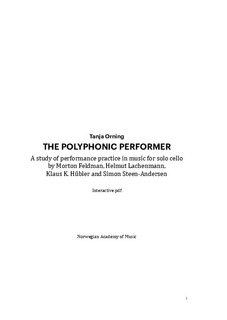| dc.description.abstract | Abstract - (for the interactive PDF 2019). The polyphonic performer. A study of performance practice in music for solo cello by Morton Feldman, Helmut Lachenmann, Klaus K. Hübler and Simon Steen-Andersen. Since World War II, a new repertoire has arisen, that in many respects proposes a new role for the cellist and the cello, breaking with the previously established role of musician. The purpose of this project is to investigate, conceptualize, and document this new role on the basis of central works by four composers of contemporary cello repertoire: Projection I (1950) and Intersection IV (1953) by Morton Feldman, Pression (1969) by Helmut Lachenmann, Opus breve (1987) by Klaus K. Hübler, and Studies #1–3 (2007, 2009, 2011) by Simon Steen-Andersen. The aesthetic strength and expressive clarity of these works provide rich incentive to explore new approaches to the music, the resources and expertise called for, and the challenges that they represent. This knowledge contributes to clarifying a contemporary performance practice, and to understanding how the musician’s role has evolved since 1950. My investigation of the performance practice circles around four main topics: notation, Werktreue (fidelity to the work or its composer), idiomaticism, and body (the physical relationship between instrument and performer). In order to explore and analyze these remarkable and peculiar pieces, we require theoretical and methodical applications that correspond to the nature and demands of the research. I argue that the performer needs new skills and expertise for this repertory, and I investigate these new requirements through my own process of practice and performance. In seeking the answers to my research questions, I draw on artistic practice as a vehicle, tool, or method that situates my study within artistic research. The project is thematically confined to the repertoire of my own instrument, the cello; however, the ambition of the project is to contribute to the expansion of the scope of discussion within the field of performance practice for performers, composers, conductors, and musicologists alike. In addition to the dissertation, the artistic result of the project comprises twelve videos of my performances of the central works, and a concert series, CELLOPRAXIS undertaken during the course of the research period. | nb_NO |
